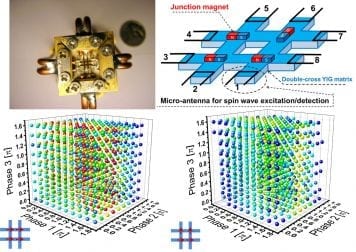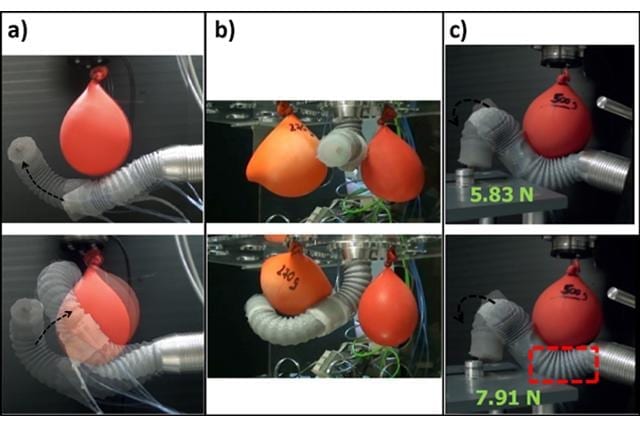
Researchers at the University of California, Riverside Bourns College of Engineering and the Russian Academy of Sciences have successfully demonstrated pattern recognition using a magnonic holographic memory device, a development that could greatly improve speech and image recognition hardware.
Pattern recognition focuses on finding patterns and regularities in data. The uniqueness of the demonstrated work is that the input patterns are encoded into the phases of the input spin waves.
Spin waves are collective oscillations of spins in magnetic materials. Spin wave devices are advantageous over their optical counterparts because they are more scalable due to a shorter wavelength. Also, spin wave devices are compatible with conventional electronic devices and can be integrated within a chip.
The researchers built a prototype eight-terminal device consisting of a magnetic matrix with micro-antennas to excite and detect the spin waves. Experimental data they collected for several magnonic matrixes show unique output signatures correspond to specific phase patterns. The microantennas allow the researchers to generate and recognize any input phase pattern, a big advantage over existing practices.
Then spin waves propagate through the magnetic matrix and interfere. Some of the input phase patterns produce high output voltage, and other combinations results in a low output voltage, where “high” and “low” are defined regarding the reference voltage (i.e. output is high if the output voltage is higher than 1 millivolt, and low if the voltage is less than 1 millivolt.
It takes about 100 nanoseconds for recognition, which is the time required for spin waves to propagate and to create the interference pattern.
The most appealing property of this approach is that all of the input ports operate in parallel. It takes the same amount of time to recognize patterns (numbers) from 0 to 999, and from 0 to 10,000,000. Potentially, magnonic holographic devices can be fundamentally more efficient than conventional digital circuits.
The work builds upon findings published last year by the researchers, who showed a 2-bit magnonic holographic memory device can recognize the internal magnetic memory states via spin wave superposition. That work was recognized as a top 10 physics breakthrough by Physics World magazine.
“We were excited by that recognition, but the latest research takes this to a new level,” said Alex Khitun, a research professor at UC Riverside, who is the lead researcher on the project. “Now, the device works not only as a memory but also a logic element.”
The Latest on: Magnonic holographic memory
[google_news title=”” keyword=”Magnonic holographic memory” num_posts=”10″ blurb_length=”0″ show_thumb=”left”]
via Google News
The Latest on: Magnonic holographic memory
- OpenAI makes 'Memory' available to all ChatGPT Plus subscribers - how to use iton April 29, 2024 at 2:37 pm
This process can be time consuming and repetitive -- that's where ChatGPT's Memory feature comes in. Also: Yikes! Microsoft Copilot failed every single one of my coding tests On Monday ...
- Neuroscientists Discover Shapeshifting DNA Controls Memory Formationon April 17, 2024 at 9:16 am
Neuroscientists have uncovered a new mechanism for memory formation, and it involves changes in the structure of your DNA. If you were asked to picture a molecule of DNA, chances are you would ...
- Ricky Burchon April 17, 2024 at 7:07 am
Select one of the buttons above to be the first person to leave a condolence. Choosing a topic and sharing a memory can help get things started.
- Raymond V. Sandson April 16, 2024 at 7:45 am
Select one of the buttons above to be the first person to leave a condolence. Choosing a topic and sharing a memory can help get things started.
- Psychologists Reveal Why You Can't Remember if You Locked Your Front Dooron April 15, 2024 at 9:57 am
To better understand how human memory works, graduate student Fernanda Morales-Calva and assistant professor Stephanie Leal showed pictures to 38 study participants. During a memory test ...
- The best memory foam mattress 2024: 9 expert-tested bedson April 12, 2024 at 3:20 am
The best memory foam mattresses excel when it comes to pressure relief as they adapt to your shape and cushion your joints, making them a good choice for side sleepers and people with aches and pains.
- Memory Newson April 10, 2024 at 5:00 pm
Does Using Your Brain More at Work Help Ward Off Thinking, Memory Problems? Apr. 17, 2024 — The harder your brain works at your job, the less likely you may be to have memory and thinking ...
- Hardware reserved memory too high in Windows; How to reduce?on December 5, 2023 at 4:00 pm
Hardware Reserved Memory is part of a computer’s physical memory or Random Access Memory (RAM), which is set aside for system hardware like the GPU (Graphics Processing Unit) and other allied ...
- Best RAM in 2024on November 7, 2023 at 2:48 am
Whether you’re purchasing or upgrading a gaming PC or everyday workstation, the component that you need to handle multiple tasks is RAM, or read-only memory. It can be quite confusing ...
- Types of Memoryon September 6, 2023 at 6:10 pm
A person’s memory is a sea of images and other sensory impressions, facts and meanings, echoes of past feelings, and ingrained codes for how to behave—a diverse well of information.
via Bing News









